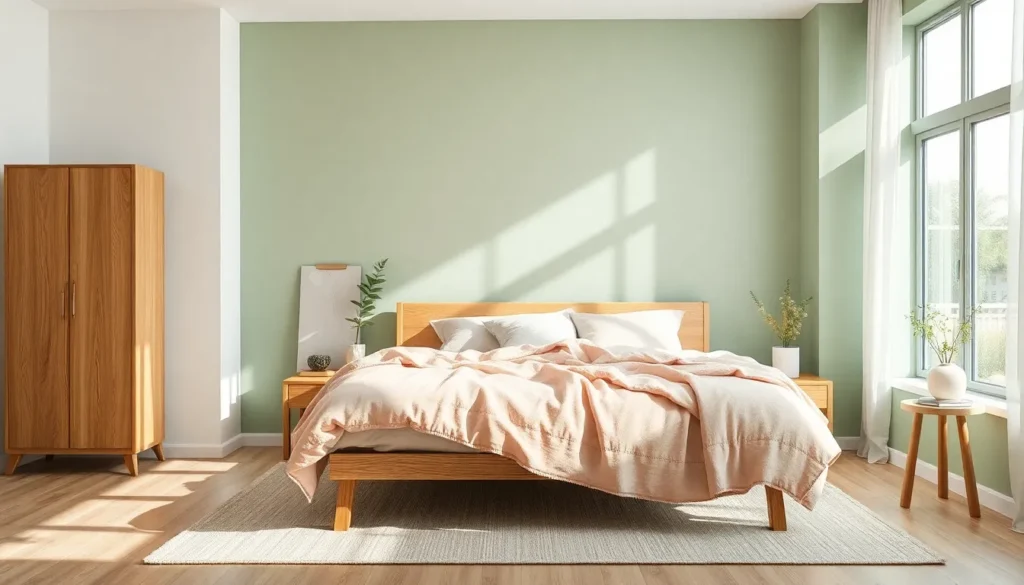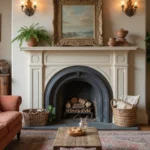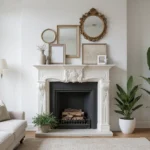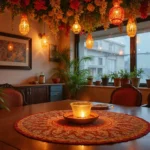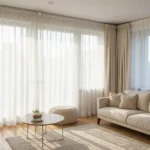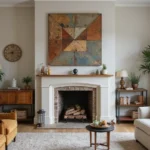We’ve all experienced that moment when we walk into our bedroom and feel completely uninspired by the same old wall colors. When boredom strikes with your current room aesthetic, choosing the right paint colors can transform your space into a comfortable sanctuary that radiates positive energy and visual appeal.
Aesthetic room paint isn’t just about following trends – it’s about creating an atmosphere that reflects your personality while promoting relaxation and comfort. From soft, neutral Korean-inspired palettes to bold two-tone combinations, there’s an aesthetic paint solution for every design preference and room concept.
Whether you’re drawn to minimalist Scandinavian whites, industrial grays, or soothing baby blue tones, the right color choice can instantly elevate your bedroom’s visual impact. The beauty of aesthetic room painting lies in its versatility – you can achieve stunning results with single-color simplicity or create dramatic focal points through strategic color combinations that highlight your furniture and personal style.
Popular Aesthetic Room Paint Colors for Modern Bedrooms
Building on these design principles, we’ve identified four standout colors that consistently deliver aesthetic appeal while maintaining modern sensibility.
Sage Green for Calming Vibes
Sage green creates an instantly soothing atmosphere that’s become synonymous with contemporary bedroom design. This muted green shade offers the perfect balance between nature-inspired freshness and sophisticated restraint. We find that sage green works exceptionally well in Korean-style bedroom designs, where it pairs beautifully with beige accents to create a homey and cozy environment.
Benefits of sage green include:
- Natural calming properties that promote better sleep
- Easy coordination with wood furniture and rattan accessories
- Versatility in both minimalist and eclectic design schemes
- Enhanced aesthetic value when combined with earth-tone elements
Soft Pastel Pink for Feminine Touch
Soft pastel pink delivers romantic elegance without overwhelming the space with boldness. This delicate hue has gained important popularity in Korean-inspired bedroom aesthetics, where it creates warmth while maintaining tranquility. We recommend pairing soft pink with white or cream furniture to achieve a sophisticated look that feels both current and timeless.
Key characteristics of soft pink:
- Creates intimate, cozy atmospheres perfect for relaxation
- Complements warm lighting and gold accent pieces
- Works beautifully with minimalist furniture arrangements
- Offers feminine appeal without sacrificing modern sophistication
Creamy White for Timeless Elegance
Creamy white stands out as a classic choice that brings warmth while maintaining the clean aesthetic of modern design. Unlike stark white, this softer variation provides the perfect backdrop for various furniture styles and decorative elements. We’ve observed that creamy white creates the illusion of larger, brighter spaces, making it ideal for smaller bedrooms.
Advantages of creamy white:
- Enhances natural light reflection throughout the room
- Coordinates seamlessly with wood, linen, and earth-tone accessories
- Supports both Japandi and Scandinavian design philosophies
- Creates versatile foundations for seasonal decorative changes
Dusty Blue for Serene Atmosphere
Dusty blue offers a gender-neutral option that brings serenity and visual interest to modern bedrooms. This sophisticated shade creates depth without darkness, making rooms feel both intimate and spacious. We find that dusty blue works particularly well when paired with white furniture, creating striking aesthetic contrasts that enhance the overall design impact.
- Provides calming psychological effects similar to ocean environments
- Matches beautifully with natural wood accents and neutral textiles
- Creates modern, unisex appeal suitable for any bedroom occupant
- Enhances mental clarity while promoting restful sleep patterns
Two-Tone Paint Combinations That Create Visual Interest
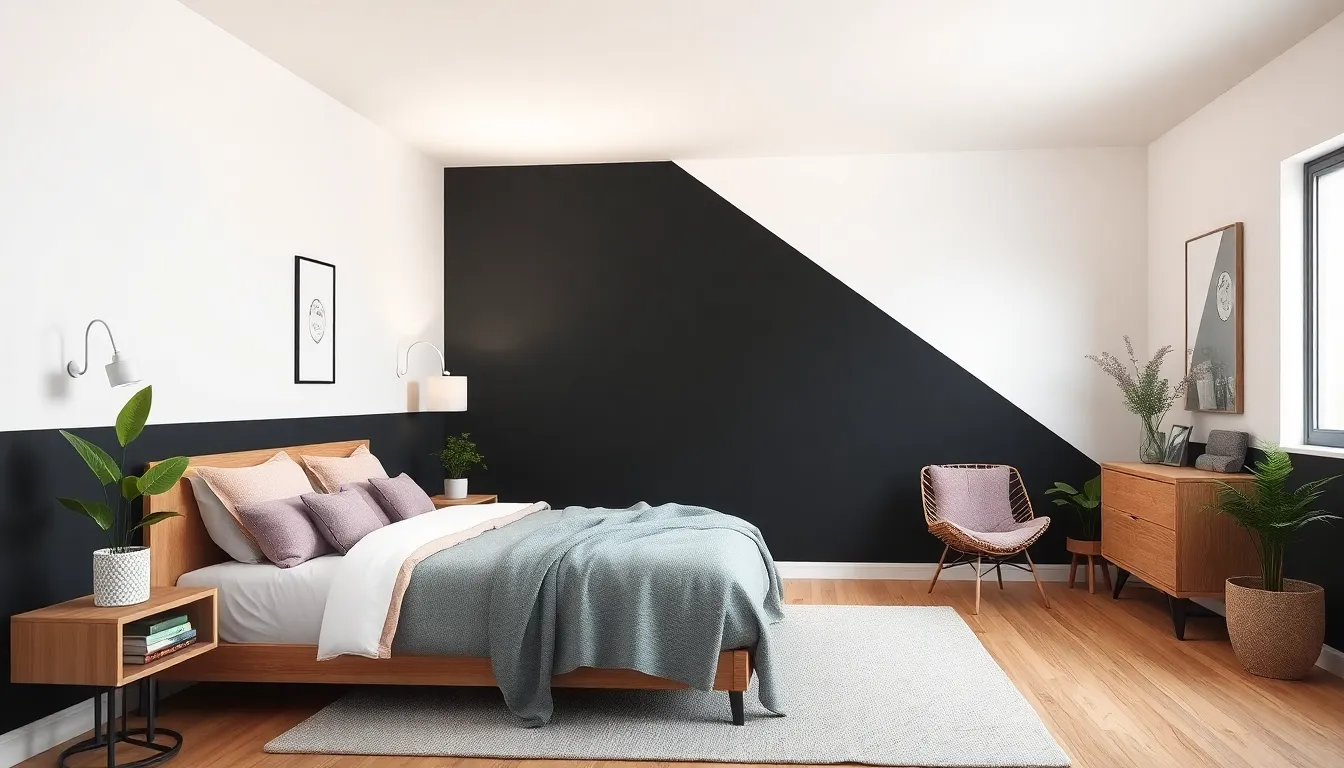
Moving beyond single-color schemes, we’ve discovered that two-tone combinations can dramatically transform your bedroom’s aesthetic appeal while maintaining that coveted modern sensibility.
Classic Black and White Contrast
Black and white combinations deliver timeless sophistication that never goes out of style. This high-contrast pairing creates a minimalist aesthetic that’s perfect for modern and contemporary bedroom designs. We recommend applying black paint to the accent wall behind your headboard while keeping the remaining walls in crisp white to avoid overwhelming the space.
Molding details on black walls add texture and dimensional depth to your room. The stark contrast makes artwork and decorative elements pop, creating natural focal points throughout the space. You can enhance this combination by incorporating geometric patterns or checkerboard designs on one feature wall while maintaining solid colors elsewhere.
Natural light becomes crucial when working with this dramatic pairing. We suggest adding mirrors or glass elements to reflect light and prevent the room from feeling too dark or enclosed.
Warm Beige and Gray Pairing
Beige and gray combinations create sophisticated neutral palettes that feel both cozy and contemporary. This pairing works exceptionally well in bedrooms where you want warmth without sacrificing modern appeal. We’ve found that using beige as the dominant color with gray accents creates the most balanced visual effect.
Temperature balance becomes essential when mixing these neutral tones. Choose warm beige shades paired with cool-toned grays to create visual interest while maintaining harmony. This combination pairs beautifully with natural materials like wood and rattan furniture.
Lighting plays a key role in bringing out the best in both colors. We recommend warm LED lighting to enhance the beige undertones while allowing the gray elements to provide sophisticated contrast.
Earth Tone Brown and Cream Mix
Brown and cream combinations deliver rich, organic aesthetics that promote relaxation and comfort. This earth-tone pairing creates a cocoon-like atmosphere that’s perfect for rest and rejuvenation. We suggest using darker brown shades on lower portions of walls with cream tones above for a two-tone effect.
Monochromatic appeal emerges when both colors share similar undertones. Dark brown and khaki variations create sophisticated depth while maintaining visual cohesion throughout the room. This approach works particularly well in smaller bedrooms with lower ceilings.
Natural textures enhance the organic feel of this color combination. We recommend incorporating wooden furniture, woven textiles, and live plants to complement the earthy palette and create a truly harmonious space.
Soft Pink and Lavender Blend
Pink and lavender combinations create dreamy, romantic atmospheres without appearing overly feminine. This soft pairing promotes tranquility and works beautifully in bedrooms designed for relaxation and self-care. We’ve seen this combination work effectively in both Korean-inspired and Scandinavian design styles.
Pastel intensity should remain consistent between both colors to maintain balance. Choose soft pink and muted lavender shades rather than bright or saturated versions to create a cohesive, calming effect. This combination pairs exceptionally well with white or cream furniture pieces.
Lighting temperature affects how these colors appear throughout different times of day. We recommend installing warm-toned lighting to enhance the cozy feeling while ensuring the colors don’t appear washed out during evening hours.
Trending Aesthetic Paint Styles by Interior Design Theme

Interior design themes have evolved to embrace exact color palettes that reflect cultural aesthetics and lifestyle preferences. We’ve identified the most popular aesthetic paint styles that transform bedrooms into Instagram-worthy spaces while maintaining functionality and comfort.
Korean-Inspired Minimalist Colors
Korean-inspired bedroom aesthetics prioritize soft, muted tones that create serene environments perfect for rest and relaxation. Cream shades serve as the foundation for this style, offering warmth without overwhelming the space with bold colors. These neutral tones pair beautifully with light wood furniture and linen textiles.
Sage green has become increasingly popular in Korean-style bedrooms, providing a calming atmosphere that promotes better sleep quality. This versatile color works exceptionally well when combined with beige accents on furniture or decorative elements. Earth tone combinations featuring soft browns, olive greens, and terracotta create natural harmony within the room.
Beige and sage green pairings offer the perfect balance between warmth and tranquility, making them ideal for those seeking a cozy yet minimalist aesthetic. Adding wooden elements or rattan accessories enhances the natural vibe while maintaining the clean Korean design philosophy.
Scandinavian Light and Airy Tones
Scandinavian design emphasizes creating bright, spacious environments through strategic color choices that maximize natural light. Pure white walls form the cornerstone of this aesthetic, making rooms appear larger and more inviting. This classic approach allows wooden furniture and natural textures to become focal points.
Creamy white variations provide subtle warmth while maintaining the clean, minimalist appearance that defines Scandinavian style. These shades work particularly well in smaller bedrooms where creating the illusion of space is essential. Light gray accents can be introduced through feature walls or ceiling treatments to add depth without compromising the airy feel.
Wood accent walls complement white paint beautifully, creating visual interest through natural textures rather than bold colors. Bamboo elements and vinyl wood flooring enhance the Scandinavian aesthetic while maintaining the connection to nature that’s central to this design philosophy.
Bohemian Warm Earth Shades
Bohemian bedroom aesthetics embrace rich, warm colors that create cozy, eclectic environments filled with personality and comfort. Terracotta and burnt orange tones serve as statement colors that add vibrancy without overwhelming the space. These earthy shades pair beautifully with cream or beige base colors.
Deep forest greens provide grounding elements that connect indoor spaces with nature, while warm browns create intimate atmospheres perfect for relaxation. These colors work exceptionally well when layered with various textures and patterns on walls and ceilings.
Multi-textural approaches define bohemian style, where different paint finishes and wall treatments create visual depth. Consider incorporating geometric patterns, textured paint techniques, or accent walls featuring bold colors like deep blues or rich purples to achieve authentic boho aesthetics.
Industrial Modern Gray Palettes
Industrial design embraces sophisticated gray palettes that create sleek, contemporary environments with urban appeal. Charcoal gray serves as a dramatic backdrop that makes modern furniture and metallic accents pop against dark surfaces. This bold choice works best when balanced with lighter elements.
Light gray combinations offer versatility for those wanting industrial aesthetics without overwhelming darkness. These neutral tones pair exceptionally well with exposed brick elements, metal fixtures, and minimalist furniture designs. Black and gray pairings create striking contrasts that define modern industrial style.
Asymmetric wood details complement gray walls beautifully, adding warmth and visual interest to otherwise stark color schemes. Consider incorporating vinyl wood flooring or wooden accent walls to soften the industrial edge while maintaining the sophisticated urban aesthetic that defines this popular design trend.
Essential Tips for Choosing the Perfect Aesthetic Paint Color
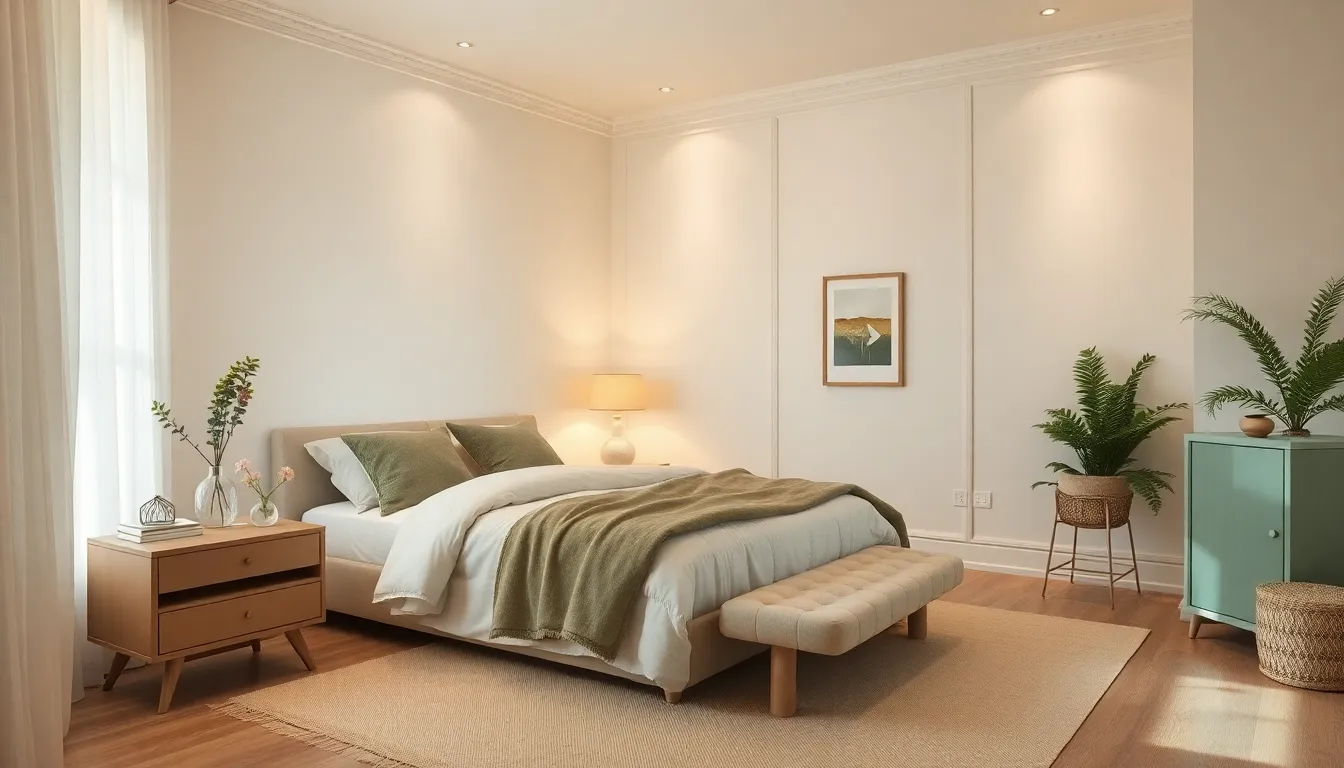
Selecting the ideal aesthetic paint color requires careful consideration of multiple factors to achieve your desired bedroom atmosphere. We’ve compiled these essential guidelines to help you make confident color choices that enhance both functionality and visual appeal.
Consider Room Size and Natural Light
Room dimensions significantly impact how paint colors appear and affect the overall ambiance of your space. We recommend lighter shades like creamy white or soft beige for smaller bedrooms, as these colors create the illusion of expanded space while maximizing available light. Larger rooms can accommodate darker tones such as sage green or dusty blue without feeling cramped or overwhelming.
Natural light availability plays a crucial role in color selection decisions. North-facing rooms with limited sunlight benefit from warm tones like soft pastel pink or beige, which compensate for cooler natural lighting. South-facing bedrooms receive abundant warm light throughout the day, making them perfect candidates for cooler shades like dusty blue or light gray that won’t appear washed out.
Match Colors to Your Furniture Style
Furniture style should guide your aesthetic paint color decisions to create cohesive design harmony. Korean-inspired minimalist furniture pairs beautifully with muted tones like sage green and cream, creating serene environments that promote relaxation. Scandinavian pieces work best with bright, airy colors such as pure white walls and light gray accents that enhance the clean, modern aesthetic.
Industrial furniture styles complement sophisticated gray palettes that create sleek, contemporary environments with urban appeal. Bohemian furniture benefits from warm earth shades like terracotta and burnt orange, which embrace rich, cozy atmospheres filled with personality. Wood furniture coordinates effortlessly with natural colors, while white furniture enhances virtually any aesthetic paint choice.
Test Paint Samples in Different Lighting
Paint samples reveal true color characteristics only when tested under various lighting conditions throughout the day. We suggest applying sample patches on multiple walls to observe how colors change from morning sunlight to evening artificial lighting. Different wall surfaces can dramatically alter color appearance, making testing essential before committing to full room coverage.
Artificial lighting sources affect paint colors differently than natural light, often shifting undertones in unexpected ways. LED lights tend to enhance cooler tones, while warm incandescent bulbs bring out yellow and red undertones in paint colors. Testing samples under your bedroom’s exact lighting setup prevents costly mistakes and ensures satisfaction with your final color choice.
Balance Bold and Neutral Tones
Strategic color balance creates visual interest without overwhelming your bedroom’s aesthetic appeal. We recommend using neutral colors like beige or light gray as your foundation, then incorporating bold accent colors through two-tone applications or accent walls. This approach allows you to experiment with trending colors while maintaining a timeless, sophisticated base.
Accent walls provide opportunities to introduce bolder aesthetic colors without dominating the entire space. Consider applying darker shades like sage green or dusty blue to one feature wall, while keeping remaining walls in complementary neutral tones. This technique adds depth and personality to your bedroom while preserving the calming atmosphere essential for restful sleep.
Creative Accent Wall Ideas for Enhanced Room Aesthetics
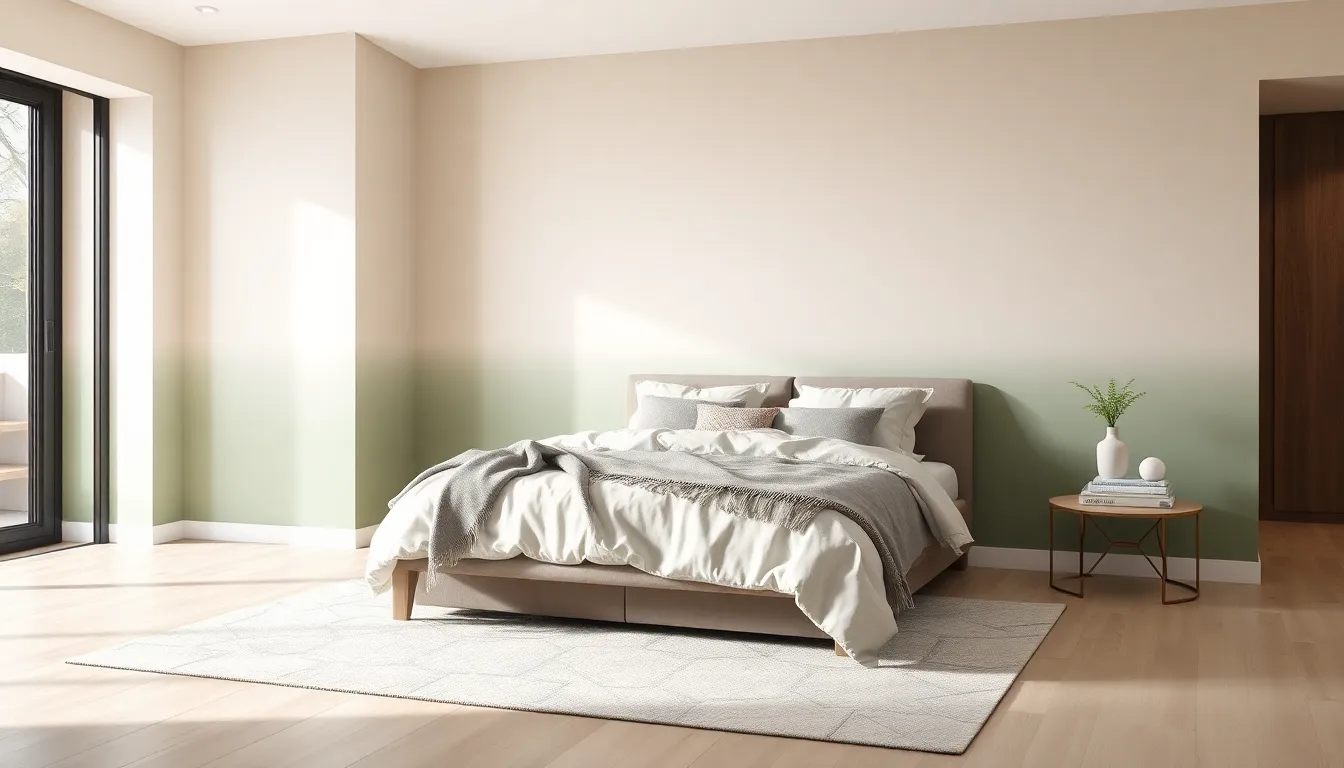
Accent walls transform ordinary bedrooms into captivating spaces by introducing ever-changing visual elements. These strategic design features create focal points that enhance the overall aesthetic appeal without overwhelming the room’s harmony.
Single Feature Wall Techniques
Single accent walls offer the most straightforward approach to creating visual impact in aesthetic bedrooms. Choose one wall to highlight, typically the wall behind your bed, and apply a contrasting color that complements your base palette. Dark colors like charcoal gray or deep sage green work exceptionally well against lighter surrounding walls, creating depth and sophistication.
Contrasting color applications make rooms appear more spacious while adding personality. Apply darker shades on accent walls while keeping remaining surfaces in neutral tones like cream or soft white. This technique prevents spaces from feeling too enclosed while maintaining the calming atmosphere essential for restful environments.
Strategic wall selection determines the success of your accent feature. Focus on walls that naturally draw attention, such as those behind headboards or opposite entrance doors. These locations maximize visual impact while creating natural focal points that enhance the room’s architectural features.
Gradient Color Transitions
Gradient paint techniques create smooth color transitions that add depth and movement to bedroom walls. Start with lighter shades at the top and gradually blend into darker tones toward the bottom, or reverse this pattern for different visual effects. Popular combinations include sage green fading to cream or dusty blue transitioning to soft white.
Ombre effects deliver sophisticated results that complement modern aesthetic styles. Use sponging or blending techniques to create seamless transitions between your chosen colors. This approach works particularly well with pastel palettes, creating dreamy atmospheres perfect for relaxation and rest.
Horizontal gradient applications make rooms appear wider and more spacious. Apply lighter colors on one side of the wall and gradually blend toward darker tones on the opposite side. This technique particularly benefits smaller bedrooms by creating the illusion of expanded space while maintaining visual interest.
Geometric Pattern Applications
Geometric patterns introduce modern sophistication through strategic shape arrangements and color combinations. Create triangular sections using tape and paint alternating colors like black and white or gray and cream. These patterns work especially well in minimalist and contemporary bedroom designs.
Checkerboard patterns deliver bold visual impact while maintaining aesthetic balance. Apply contrasting colors in square or rectangular sections to create ever-changing wall features. This technique suits industrial and modern design styles, particularly when using monochromatic color schemes.
Striped patterns elongate walls and add vertical or horizontal emphasis to bedroom spaces. Vertical stripes make ceilings appear higher, while horizontal stripes create the illusion of wider rooms. Use painter’s tape to achieve clean lines and professional results with your chosen color combinations.
Textured Paint Finishes
Textured paint applications add dimensional interest that enhances light reflection and visual depth. Apply techniques like stippling, ragging, or sponging to create surface variations that catch light differently throughout the day. These methods work particularly well with neutral colors like beige, cream, and light gray.
Molding combinations with contrasting colors create sophisticated architectural details. Install decorative molding on accent walls and paint them in complementary shades to your base color. This technique adds elegance and dimension, particularly effective with black molding against white walls or cream molding on sage green surfaces.
Fabric texture effects simulate luxury materials through specialized painting techniques. Use tools like combs, brushes, or rollers to create patterns that mimic linen, silk, or other textile surfaces. These finishes add warmth and comfort to aesthetic bedrooms while maintaining the clean lines essential for modern design styles.
Common Mistakes to Avoid When Painting Your Aesthetic Room
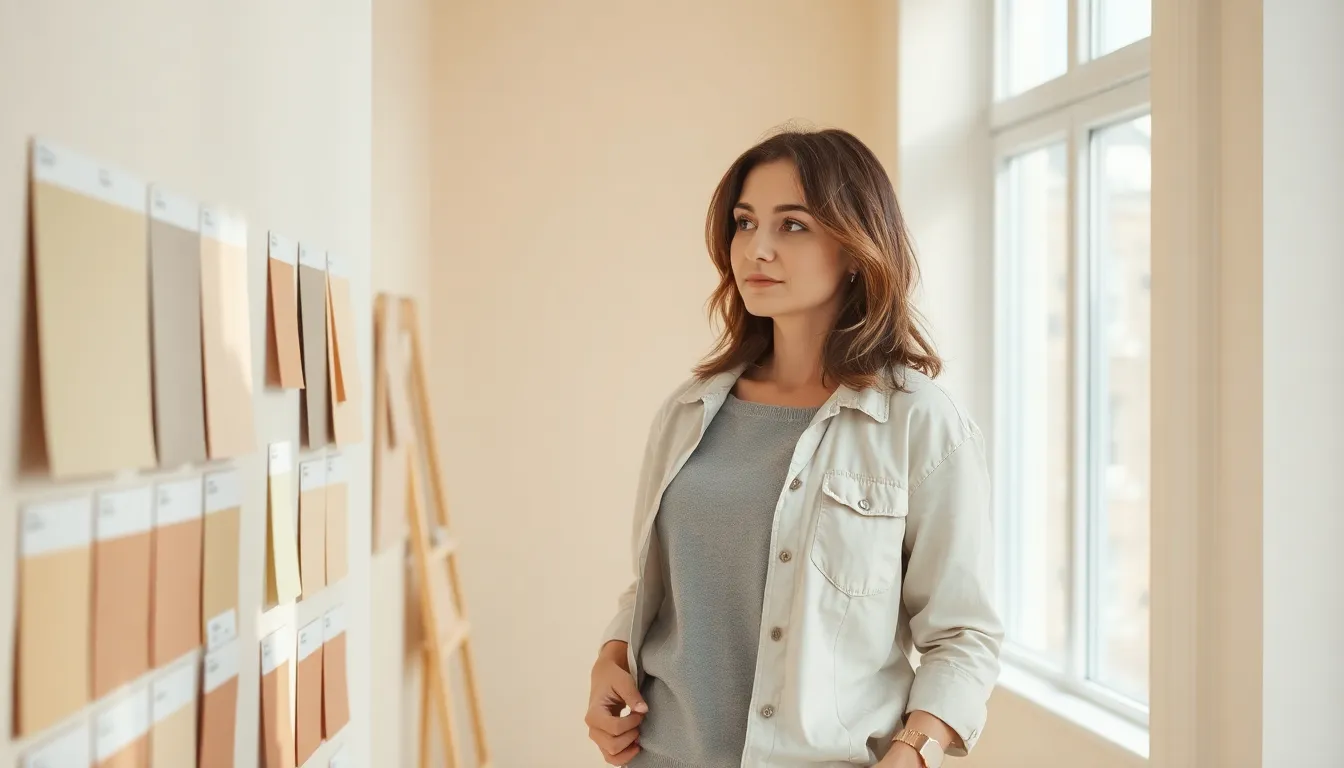
Ignoring lighting conditions ranks as the most critical error we see homeowners make when selecting aesthetic paint colors. Natural light intensity varies significantly throughout the day, and artificial lighting can dramatically alter how colors appear on your walls. Testing paint samples on different wall sections under various lighting conditions prevents disappointing color choices that look perfect in the store but clash with your room’s unique environment.
Choosing colors without considering room size creates visual problems that can make spaces feel cramped or overwhelming. Dark colors like navy or burgundy can make small bedrooms feel even more confined, while light shades such as cream and beige help create the illusion of larger spaces. Rooms with ample square footage offer more flexibility for experimenting with bold color combinations, but maintaining balance between light and dark tones remains essential.
Skipping the sample testing phase leads to costly mistakes that could easily be prevented. Paint manufacturers’ color cards often mislead customers because colors appear different under showroom lighting compared to your bedroom’s natural conditions. Applying small test patches on multiple walls allows you to observe how colors change throughout different times of day before committing to full room coverage.
Mismatching paint colors with interior style creates visual discord that undermines your aesthetic goals. Minimalist designs work best with monochromatic schemes like gray and white combinations, while vintage or classic styles benefit from richer pairings such as burgundy and beige. Understanding your room’s overall design theme before selecting paint colors ensures harmonious results that enhance rather than compete with your existing decor.
Overlooking contrast principles results in flat, uninteresting color schemes that lack visual depth. High contrast combinations like black and white create modern, elegant appearances, while low contrast pairings such as cream and brown produce softer, more subtle effects. Balancing these contrast levels according to your desired atmosphere prevents rooms from appearing either too stark or overly bland.
Forgetting about color psychology effects can negatively impact your room’s functionality and mood. Certain color combinations may look appealing but fail to promote restful sleep or relaxation in bedroom environments. Warm lighting and natural material accents like rattan or wood help create comfortable, inviting atmospheres that complement your chosen paint colors.
Rushing the decision making process often leads to choices you’ll regret later. Taking time to consider how different colors align with your personal preferences and lifestyle needs ensures satisfaction with your final selection. Creating a cohesive color palette that reflects your individual style while maintaining aesthetic appeal requires thoughtful planning rather than impulsive choices.
Conclusion
Creating the perfect cat kamar aesthetic isn’t just about following trends—it’s about crafting a space that truly reflects who we are while promoting rest and tranquility. We’ve explored how strategic color choices can transform our bedrooms from ordinary spaces into personal sanctuaries.
Whether we choose calming sage green for its soothing properties or embrace bold two-tone combinations for visual impact the key lies in understanding how colors work with our existing furniture and natural light. We’ve seen how accent walls can add depth without overwhelming the space.
Remember that our bedroom should serve as a retreat from daily stress. By avoiding common painting mistakes and testing samples thoroughly we can create an aesthetic that not only looks stunning but also supports our well-being for years to come.
Frequently Asked Questions
What makes a bedroom paint color aesthetic?
Aesthetic bedroom paint colors reflect personal style while promoting relaxation and visual appeal. They create a harmonious atmosphere that transforms your space into a comfortable sanctuary, using soft neutrals, muted tones, or strategic color combinations that enhance the room’s natural light and complement your furniture style.
Which paint colors are best for small bedrooms?
Lighter shades like creamy white, soft pastels, and sage green work best for small bedrooms. These colors reflect natural light effectively, creating the illusion of larger spaces while maintaining a cozy atmosphere. Avoid darker colors as they can make small rooms feel cramped and overwhelming.
How do I choose between warm and cool paint colors?
Consider your room’s natural light and desired mood. Cool colors like dusty blue and sage green promote relaxation and work well in south-facing rooms with abundant light. Warm colors like soft pink and creamy white add coziness and are ideal for north-facing spaces that receive less natural light.
What are the most popular aesthetic bedroom colors in 2025?
The top aesthetic bedroom colors include sage green for its calming properties, soft pastel pink for romantic vibes, creamy white for versatility and light enhancement, and dusty blue for gender-neutral serenity. These colors work well with modern minimalist and Korean-inspired design styles.
Should I use single colors or two-tone combinations?
Both options can create stunning aesthetic results. Single colors offer simplicity and cohesion, while two-tone combinations add visual interest and depth. Popular combinations include black and white for contrast, beige and gray for warmth, and soft pink with lavender for a dreamy atmosphere.
How do I test paint colors before committing?
Always test paint samples on your walls under different lighting conditions throughout the day. Paint small sections and observe how colors look in morning sunlight, afternoon light, and evening artificial lighting. This prevents costly mistakes and ensures satisfaction with your final choice.
What paint colors work best with different design styles?
Korean minimalist styles favor soft, muted tones like cream and sage green. Scandinavian designs use pure white and light gray. Bohemian styles embrace warm earth tones like terracotta. Industrial modern themes feature sophisticated gray palettes with urban appeal.
Can I use accent walls in aesthetic bedroom design?
Yes, accent walls are excellent for adding visual interest while maintaining balance. Use contrasting colors, gradient transitions, geometric patterns, or textured finishes on one wall. This creates a focal point without overwhelming the space, perfect for introducing bolder colors in neutral rooms.

